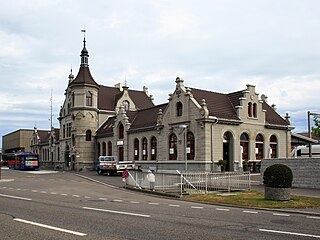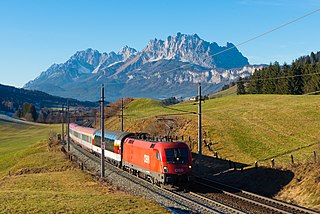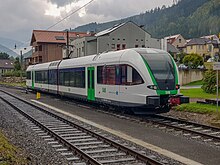
The S-Bahn, lit. 'S-Train', is a hybrid urban–suburban rail system serving a metropolitan region predominantly in German-speaking countries. Some of the larger S-Bahn systems provide service similar to rapid transit systems, while smaller ones often resemble commuter or even regional rail systems. The name S-Bahn derives from Schnellbahn, Stadtbahn or Stadtschnellbahn.

The Zurich S-Bahn system is a network of rail lines that has been incrementally expanded to cover the ZVV area, which comprises the entire canton of Zurich and portions of neighbouring cantons, with a few lines extending into or crossing the territory of southern Germany. The network is one of many commuter rail operations in German speaking countries to be described as an S-Bahn. The lines connect with services of Aargau S-Bahn to the West, Basel S-Bahn and Schaffhausen S-Bahn to the North, St. Gallen S-Bahn to the East, and Lucerne S-Bahn/Zug Stadtbahn to the South, as well as with InterCity, InterRegio and RegioExpress services at major junction stations.

The Munich S-Bahn is an electric rail transit system in Munich, Germany. "S-Bahn" is the German abbreviation for Stadtschnellbahn, and the Munich S-Bahn exhibits characteristics of both rapid transit and commuter rail systems.

The Hamburg S-Bahn is a rapid transit railway system in the Hamburg Metropolitan Region. Together, the S-Bahn, the Hamburg U-Bahn, the AKN railway and the regional railway form the backbone of railway public transport in the city and the surrounding area. The network has operated since 1907 as a commuter rail system, under the direction of the state railway, and is a member of the Hamburger Verkehrsverbund. There are four lines, serving 68 stations, on 147 kilometres (91 mi) of route. On an average working day the S-Bahn transports about 590,000 passengers; in 2010 about 221 million people used the S-Bahn.

The Stuttgart S-Bahn is a suburban railway system (S-Bahn) serving the Stuttgart Region, an urban agglomeration of around 2.7 million people, consisting of the city of Stuttgart and the adjacent districts of Esslingen, Böblingen, Ludwigsburg and Rems-Murr-Kreis.

Rail transport in Austria is mainly provided by Austria's national rail transport company, the Austrian Federal Railways, which also manages rail transport in Liechtenstein. The Austrian railway network has a length of 6,123 km (3,805 mi), 3,523 km (2,189 mi) of which are electrified. Most lines are in 1,435 mmstandard gauge, while especially in the Alpine region there are several narrow-gauge railway lines and funiculars.

Munich-Pasing is a railway station in the west of Munich. It is the third-largest station in the city, after München Hauptbahnhof and München Ost.

The Rhine-Main S-Bahn system is an integrated rapid transit and commuter train system for the Frankfurt/Rhine-Main region, which includes the cities Frankfurt am Main, Wiesbaden, Mainz, Offenbach am Main, Hanau and Darmstadt. The network comprises nine S-Bahn lines, eight of which currently travel through the cornerstone of the system, a tunnel through central Frankfurt. The first section of this tunnel was opened on May 28, 1978. Further tunnel sections were opened in 1983 and 1990, before its completion in 1992. The system belongs to the Rhein-Main-Verkehrsverbund (RMV) and is operated by DB Regio, a subsidiary of Deutsche Bahn.

Mannheim Hauptbahnhof is a railway station in Mannheim in the German state of Baden-Württemberg. It is the second largest traffic hub in southwestern Germany behind Stuttgart Hauptbahnhof, with 658 trains a day, including 238 long-distance trains. It is also a key station in the Rhine-Neckar S-Bahn. 100,000 passengers embark, disembark or transfer between trains at the station each day. The station was modernised in 2001. It is classified by Deutsche Bahn as a category 2 station.

Hamburg Airport (Flughafen) is a station on line S1 of the Hamburg S-Bahn, serving Hamburg's airport in the quarter of Fuhlsbüttel in the northeast of the city. It opened in 2008. According to S-Bahn Hamburg GmbH — owner and operator of the S-Bahn — about 13,500 passengers used the service per day in 2009, with an increase to 20,000 daily passengers by 2013. The station's name is identical in both English and German with the English word "airport" being used primarily in both languages and with the German equivalent "Flughafen" added in brackets.
The Frankfurt Airport loop is a 15.8-kilometre-long (9.8-mile) double-track railway line connecting Frankfurt and Frankfurt Airport and operated as part of the Frankfurt S-Bahn. It is electrified at 15 kV/16.7 Hz.

Rapperswil railway station is located next to the old town and harbour of Rapperswil in the Swiss canton of St. Gallen. It is the largest of four active railway stations in the municipality of Rapperswil-Jona. Rapperswil railway station is situated on the north shore of Lake Zürich at the northern end of the Seedamm, which separates the Obersee from the main body of the lake.

The Salzburg-Tyrol Railway is a main line railway in Austria. It runs through the states of Salzburg and Tyrol from the city of Salzburg to Wörgl and belongs to the core network (Kernnetz) of the Austrian Federal Railways (ÖBB). The section between Salzburg and Schwarzach-Sankt Veit is part of the Salzburg S-Bahn urban railway network.

The Koralm Railway is an Austrian 127 km-long (79 mi) double-track, electrified, high-speed railway currently under construction. It will connect the cities of Graz and Klagenfurt. Construction started in 2001; the entire railway line is expected to be operational in December 2025.

Ziegelbrücke railway station is a junction station in the village of Ziegelbrücke in Switzerland. Whilst the village is shared between the municipality of Glarus Nord, in the canton of Glarus, and the municipality of Schänis, in the canton of St. Gallen, the station is located in the Gemarkung of Schänis, where it is the larger of two railway stations.

The Zurich–Winterthur railway is Switzerland's busiest railway line. Opened in 1855, it runs from Zürich Hauptbahnhof to Winterthur via several routes. It is a bottleneck in Swiss rail transport. Practically all lines of the core network of the Zurich S-Bahn use parts of this line.

The Rudolf Railway refers to a railway in Austria connecting Amstetten and the Italian border near Tarvisio, along with a branch from Kastenreith to St. Valentine. Its name is derived from the k.k. priv. Kronprinz Rudolf-Bahn Gesellschaft. The main line, which was opened from 1868 to 1873, ran on the St. Valentin–Kastenreith–Kleinreifling–Selzthal–Schoberpass–St. Michael–Neumarkt saddle–St. Veit an der Glan–Feldkirchen in Kärnten–Villach–Tarvisio Centrale route. The section of the line within the current borders of Italy now runs over the new Tarvisio–Udine railway through Tarvisio Boscoverde. It replaced a very windy route to Udine that originally formed part of the Rudolf Railway.

Seehas is a regional rail service that operates between Engen and Konstanz in the district of Konstanz, in Baden-Württemberg, Germany. It is managed and operated by SBB GmbH, the German subsidiary of Swiss Federal Railways. It began operation in 1994.

The Köflach railway line is a standard gauge railway line in the province of Styria in Austria. It runs 40.2 kilometres (25.0 mi) from a junction with the Southern railway line at Graz Hauptbahnhof to Köflach. Graz-Köflacher Bahn und Busbetrieb (GKB) owns and operates the line.

Radolfzell station is the main railway station in the municipality of Radolfzell am Bodensee, Baden-Württemberg, Germany. It is an important junction station in the western part of Lake Constance. The station is located along the standard gauge High Rhine Railway line and is also the western terminus of the Radolfzell–Mengen railway line. It is therefore one of the main nodal points of the Lake Constance Belt Railway.























